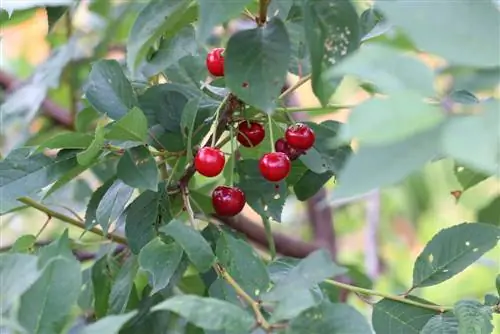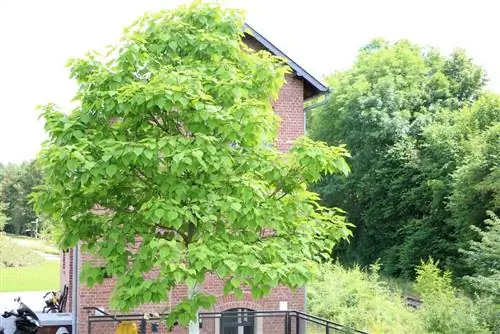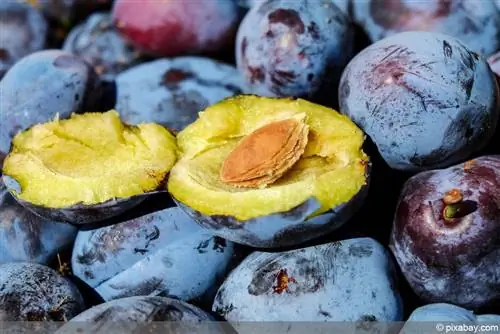- Author admin [email protected].
- Public 2023-12-17 03:39.
- Last modified 2025-01-24 12:45.
Apricot trees are mainly grown in the warm and sunny Mediterranean countries. But the tree can also feel comfortable and thrive in the local latitudes with proper care and the correct site conditions. It then rewards the gardener with sweet-smelling flowers and wonderfully juicy fruits. However, the plant is very sensitive to frost, so not every location is suitable. In addition, it needs sufficient protection from cold temperatures in winter. Regular pruning and moderate watering are crucial for good growth.
Location
The apricot tree prefers warm locations with lots of hours of sunshine because it comes from southern countries. That's why it doesn't cope particularly well with the cold temperatures of the northern regions and relies on additional protection. Frosts that occur particularly late can damage the tree if it has already sprouted. For this reason, it should only get a little sun in its location in spring, so that budding occurs later.
- A protected valley with lots of warmth and sun is optimal
- Plan protection from rain and wind
- Continuous drafts should be avoided
- Proximity to a house wall or wall is ideal
Plants
The apricot tree feels very comfortable in the garden bed if it has enough space. In addition, it depends on additional protection against ground frost, which should warm the ground in the long term. If you want to enjoy your little tree as soon as possible, you can buy pre-ordered goods from specialist retailers.
- Plant in spring, March is ideal
- In colder regions it is better to wait until April
- Dig a planting hole twice as large as the root ball
- Loosen up the soil deeply, create drainage
- Enrich the excavation with compost and horn shavings
- Pull the root ball apart slightly
- Remove breaks and kinks directly
- Short shoots by a third
- Soak the ball in the container with water, then plant it
- After planting, press the soil well
- Planting site should be 5 cm above the ground
- Water thoroughly immediately afterwards
- Cover with black foil or mulch
pot planting
If the apricot tree is to grow in regions with a harsh climate and often late ground frosts, then growing it in a large flower pot or a bucket is a good idea. The smaller varieties are particularly suitable for keeping in pots. Planting in a container allows for individual location changes so that the tree can overwinter undamaged in a frost-free winter quarters. However, too much moisture should be avoided right from the start.
- Choose a bucket with a capacity of at least 30 liters
- Hole in the ground prevents harmful waterlogging
- Integrate drainage over the hole, made of gravel and pottery shards
- Distribute the substrate directly over the drainage
- Place the plant in the center of the pot
- Fill the vessel step by step
- Press between the soil with your fingers
- Inserted wooden post gives the tree a secure hold
- Finally, water well with rainwater
Substrate & Soil
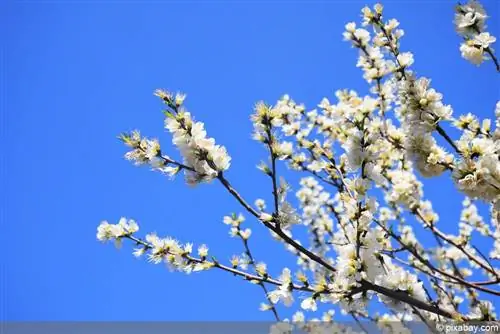
The apricot tree does not tolerate waterlogging, which is why extremely loamy and clayey soils must be prepared accordingly before planting in order to make the subsoil more permeable to water. In this way, the oxygen supply to the roots is also ensured. However, larger air holes must be avoided at all costs, as these have a negative effect on root growth.
- Prefers light and sandy soils
- If the soil is too firm, create drainage directly below the root ball
- Integrate drainage made of gravel or coarse gravel
Repotting
If all site conditions are right, the apricot tree can grow quickly in height and width. Then repotting into a larger container is necessary.
- Check root growth regularly
- Repot the tree if there is not enough space in the container
- However, only repot if necessary so as not to stress the plant unnecessarily
Pouring
The apricot tree prefers dry warmth, interrupted by occasional rain. If it rains too often, the flowers and fruits suffer. If you water too many times, the roots will quickly begin to rot. If a lot of precipitation is expected at the location, then rain protection is very helpful. However, too little water leads to dried leaves, and extremely long periods of drought even inhibit the growth of the fruits. Depending on the location, the water from the tap is often very hard and calcareous, which the tree does not tolerate well.
- Keep root balls only partially moist
- Never water too much
- Check the soil using a finger test before each new watering unit
- Always let the top layer of soil dry first
- Watere more frequently in the hot summer months with too little rain
- Projection under house roof or terrace roof useful as rain protection
- Ideally water with collected rainwater
Fertilize
The apricot tree is relatively undemanding, so normal units are sufficient for fertilizing. However, more fertilizer can be used during flowering and shortly before harvest; the tree will thank you with a crown full of fruit.
- Fertilize during the growing season, from spring to autumn
- Use fertilizer for fruit trees about once a month
- Mineral fertilizers are not recommended
Cutting instructions
Basically, all fruit-bearing trees must be pruned, including the apricot tree. In this way, a balanced relationship can be established between the roots and the part of the tree growing above the surface of the earth. The stronger the plant grows, the more of the top growth needs to be cut off. Otherwise it may happen that the roots are unable to adequately supply extremely tall branches. However, do not make the pruning too extreme; instead, proceed cautiously and carefully. In this way you can avoid only thin shoots growing back. If the tree is located in close proximity to buildings and walls, pruning should begin at the right time to prevent damage caused by excessive growth.
- Generally plan pruning during the growing season
- In the winter season, sore spots are difficult to close
- Harmful pathogens can penetrate more easily through wounds
- Ideally, tree pruning should be carried out immediately after harvesting
- If necessary, pruning can also be done before the flowering period
- Thin out branches that are too dense periodically
- Lighten the treetop to let the sun's rays through
- Significantly shorten extremely long shoots
- Cut complex to promote even tree growth
- A strong branch is desired, with only a few branches
- Only apply tree resin to seal extremely large wounds
- Make all cuts straight and clean
- Work with sharp secateurs, clean them sufficiently beforehand
- Prune off dead and diseased branches regularly
Tip:
The use of wound closure agents should be avoided if possible, as water often accumulates under this layer, creating an optimal breeding ground for harmful fungi.
Harvest time

Ideally, apricots are harvested sequentially, which means that the fruits are picked off little by little during the harvest season. When the apricots are ripe for harvesting, the dark side is also colored yellow. Apricot trees are self-fertile, so no other tree is needed to produce the fruit.
- Check regularly for ripe fruit during the harvest season
- Never harvest the whole tree at the same time
- Remove fruit that is already rotting as soon as possible
Refining by inoculation
Occulation is a very cost-effective variant of reproduction; only one bud from an already grafted apricot tree is required. However, the cut required for this is not easy to carry out. If you are unsure, you can practice on another branch first. It is important to ensure that you never touch the interfaces as this will contaminate them. As a result, the tree can then become infected with diseases. Growing using this method takes approximately 6 weeks, and the eye must always remain green. If there is a change in colors, then the finishing has not been successful.
- Make a vertical cut in the bark, approx. 2-3 cm long
- Make a second cut at the end of the cut, horizontally and about 2 cm wide
- Remove both bark shells from the wood to form a bag
- Don't insert the knife too deep
- Push the eye between the bark wings
- Check tightness
- Tuck pieces of bark firmly around the eye
- Now wrap with finishing tape
- Eye starts sprouting after some time
Diseases and pests
Diseases often occur due to incorrect care and a location that is not suitable for the apricot tree. Permanently moist and extremely wet plant substrate supports the emergence of pests. For this reason, the plant should be checked regularly, especially during overwintering.
Frost tensioner
The frost moth is a butterfly whose caterpillars eat leaves and fruit, causing great damage. If the leaves have holes and look like they are woven together, this is a sure sign of an infestation. Great tits are very useful in the garden as they eat the caterpillars.
- The use of Bacillus Thuringiensis remedies is helpful
- Apply the product in warm weather, caterpillars are particularly hungry then
- As a preventive measure, install nesting boxes for birds near the tree
Frizz disease
If the young leaves change color and form bubbles, curl disease is often to blame. This is a fungal disease that causes the leaves and fruits to die. Relief measures should not come too late, otherwise they will no longer work.
- Fight with sprays containing copper
- Use the product in winter, before the first buds appear
- If the infestation is very advanced, completely remove all affected areas
Shotgun Disease
If round leaf spots form that then become holes, then it is shotgun disease. The name comes from the shape of the holes, which are reminiscent of shotgun fire.
- Use fungicides as antidotes
- Apply preparations in damp weather conditions
- Products containing copper, sulfur and clay are harmless to the environment
Bacterial fire
If small, brown spots form on the edge of the leaves and the leaves then die, then bacterial blight is to blame. As a protective measure, the apricot tree secretes increased amounts of resin, black spots form on the fruits and the bark becomes recessed. At the end of summer the disease stops and the fungus dies completely.
- Unfortunately, control is not possible during the infestation
- Prevention with regular whites
- Inject copper-containing products early on
Tip:
If fungal infestation and pests often occur, then planting garlic and onions under the apricot tree can help as a preventive measure, as their presence is not particularly popular.
Propagate
With a little patience, you can grow an apricot yourself from a kernel. However, it can take quite a long time for the newly growing offspring to break through the hard core shell. In addition, the young plant needs time before it can be planted in the garden. For ideal growth conditions, mold growth and waterlogging must be avoided at all costs, which is why the planter should have a drainage hole. A warm and bright location that does not receive direct sunlight is ideal. When the small apricot sprout has grown a few centimeters tall, it can be moved to a larger container.
- Use germ-free plant substrate, rich in nutrients
- Air-permeable soil is ideal, enrich with a little sand
- Only one seed per flower pot, remove the pulp from it
- Insert the core approx. 1 cm deep and to the side
- Then moisten well, but don't let it get too wet
- Avoid fertilizer in the beginning
Wintering
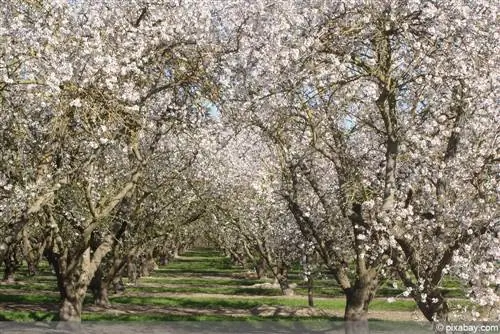
Apricot trees only need a short winter break and sprout again early in the beginning of spring. For this reason, late ground frosts cause lasting damage. Most trees can usually survive regional winter months and cold temperatures well. However, an extremely early warm period can stimulate the sap flow at the wrong time, for example in February or March. If another cold phase sets in afterwards, it weakens the tree. The flowers can tolerate a bit of frost for a short time, but not for too long. The plant reacts extremely sensitively to persistent snowfalls and cold precipitation. Without adequate protection at this stage of development, the risk of a failed harvest increases. When grown in a bucket, the apricot tree can overwinter in appropriate quarters.
- Check possible locations in the garden for their suitability for overwintering
- Sheltered places are ideal, in front of a sunny house wall or under a canopy
- Protect against frost with fleece during cold periods in March and April
- Potted plants need a bright winter quarters
- Frost-free winter gardens are ideal
- Alternatively, set up in the light-flooded attic
- Cold and permanent drafts should be avoided
- Water the tree only now and then, otherwise leave it alone
- Brighten extremely dark locations with plant lamps
Conclusion
The apricot tree is an ornament for every garden and produces beautiful and fragrant flowers in spring. The plant is relatively easy to care for if the site conditions are right. At the end of the summer season, sweet and vitamin-rich fruits, also known as apricots, grow. However, fruit formation only occurs if everything went well together in advance. Since the apricot cannot tolerate late frost periods, it relies on additional protective measures, especially at the end of winter. In rather cool regions, the choice of location is very important; south-facing and sheltered places with lots of sun are ideal. Extremely rainy phases are not tolerated well, in which case planting in containers is recommended. In this way, the apricot tree can move depending on the weather and overwinter in suitable quarters.


